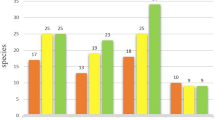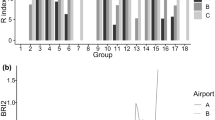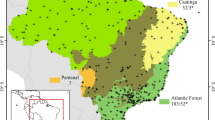Abstract
Airports are peculiar developed habitats that, besides being extremely noisy and unappealing to some bird species, are highly attractive to others. Bird–aircraft collisions, or birdstrikes, cause losses in terms of human lives, direct monetary losses and associated costs for the civil aviation industry. In recent years, birdstrike risk assessment studies have focused on the economical aspects of the damage caused by wild animals and the hazards of wildlife–aircraft collisions, while an ecological approach, taking into account animal behaviour for the analysis of such events, has seldom been adopted. We conducted a risk analysis for birdstrikes at the Venice Marco Polo International Airport (VCE), Italy. We defined the key variables involved in these events and summarised their interactions in a single metric risk index we called the “Birdstrike Risk Index” (BRI). Our aim was to provide a tool for birdstrike risk analysis that described the risk on the basis of the actual presence of birds at airports. The application of the BRI at VCE allows relative risks across species to be defined, providing information for prioritising management actions. Furthermore, due to the seasonality of bird species presences, the application of the BRI to a long-term data series should give clues of birdstrike risk in future scenarios. This new ecological approach that we applied to a particular airport could easily be adapted for use at other airports worldwide and integrated into risk assessment procedures. The study results and the BRI tool are addressed to scientific consultants of airport safety managers.





Similar content being viewed by others
References
Allan JR (2000) Protocol for bird strike risk assessment at airports. IBSC25/WP-OS3
Allan JR (2006) A heuristic risk assessment technique for birdstrike management at airports. Risk Anal 26:723–729
Anagnostopoulos A (2003) Bird strike risk assessment for Athens International Airport. IBSC26/WP-AE2
Barras SC, Dolbeer RA (2000) Reporting bias in birdstrikes at John F. Kennedy International Airport, New York, 1979–1998. Proceedings of 25th International Birdstrike Committee. Amsterdam
Barras SC, Seamans TW (2002) Habitat management approaches for reducing wildlife use of airfields. Proc.20th Vertebrate Pest Conference. University of California, Davis
Barras SC, Wright SE (2002) Civil aircraft collisions with birds and other wildlife in Ohio, 1990–1999. Ohio J Sci 102:2–7
Barras SC, Dolbeer RA, Chipman RB, Bernhardt GE, Carrara MS (2000) Bird and small mammal use of mowed and unmowed vegetation al John F. Kennedy international airport, 1998 to 1999. Proceedings of the 19th Vertebrate Pest Conference. University of California, Davis
Baudains TP, Lloyd P (2007) Habituation and habitat changes can moderate the impacts of human disturbance on shorebird breeding performance. Anim Conserv 10:400–407
Blockpoel H (1976) Bird hazards to aircraft: problems and prevention of bird/aircraft collisions. Clarke, Irwin, Canada
CAA (1998) CAP680 Bird control on aerodromes. Civil Aviation Authority, London
Clinchy M, Zanette L, Boonstra R, Wingfield JC, Smith JNM (2004) Balancing food and predator pressure induces chronic stress in songbirds. Proc R Soc Lond B Biol Sci 271:2473–2479
Conomy JT, Dubovsky JA, Collazo JA, Fleming WJ (1998) Do black ducks and wood ducks habituate to aircraft disturbance? J Wildl Manage 62:1135–1142
Cramp S, Simmons KEL (1983) Handbook of the birds of Europe, the Middle East and North Africa: the birds of the Western Palearctic. Oxford University Press, Oxford
De Fusco RP, Harper JT, Ruhe W (2005) Alaska bird avoidance model (AK BAM) development and implementation. Proceedings of 27th International Birdstrike Committee. Athens
Dekker A, Buurma L (2003) Zero-tolerance a panacea? IBSC 26/WP-OS6
Dolbeer RA (2000) Birds and aircrafts: fighting for airspace in crowded skies. Proc.19th Vertebrate Pest Conference. University of California, Davis
Dolbeer RA (2006) Height distribution of birds recorded by collisions with civil aircraft. J Wildl Manage 70:1345–1350
Dolbeer RA, Belant JL, Sillings JL (1993) Shooting gulls reduces strikes with aircraft at Kennedy, John F. International-Airport. Wildl Soc Bull 21:442–450
Dolbeer RA, Belant JL, Bernhardt GE (1997) Aerial photography techniques to estimate populations of laughing gull nests in Jamaica Bay, New York, 1992–1995. Colon Waterbirds 20:8–13
Dolbeer RA, Wright SE, Cleary EC (2000) Ranking the hazard level of wildlife species to aviation. Wildl Soc Bull 28:372–378
ENAC (1999) ENAC Advisory Circular APT01. Ente Nazionale Aviazione Civile, Italy
ENAC (2007) ENAC advisory Circular APT01-A. Ente Nazionale Aviazione Civile, Italy
FAA (2004) Hazardous wildlife attractants on or near airports. FAA Advisory circular 150/5200-33A. Federal Aviation Administration, Washington, DC
Fennessy G, Kelly TC, Bolger R, Sheehy S, O'Callaghan MJA (2005) Ground versus air-seasonal changes is the use by birds of an Irish airport. Proceedings of 27th International Birdstrike Committee. Athens
Fitzpatrick S, Bouchez B (1998) Effects of recreational disturbance on the foraging behaviour of waders on a rocky beach. Bird Study 45:157–171
Gleizer H, Bar P, Bahat O, Groner E, Ovadia O (2005) The effect of habitat productivity and structure on bird spatial distribution in an airfield located at a semi-arid region. Proceedings of 27th International Birdstrike Committee. Athens
Leshem Y, Ovadia O, Dinevich L, Raz O (2005) A national network of bird and weather radars in Israel—from vision to reality. Proceedings of 27th International Birdstrike Committee. Athens
Lovell CD, Dolbeer RA (1999) Validation of the United States Air Force bird avoidance model. Wildl Soc Bull 27:167–171
Mallord JW, Dolman PM, Brown AF, Sutherland WJ (2007a) Linking recreational disturbance to population size in a ground-nesting passerine. J Appl Ecol 44:185–195
Mallord JW, Dolman PM, Brown AF, Sutherland WJ (2007b) How perception and density-dependence affect breeding Woodlarks Lullula arborea. Ibis 149:15
Matijaca A (2005) Court judgements: pro & contra. Proceedings of 27th International Birdstrike Committee. Athens
Montemaggiori A (1998) The importance of bird monitoring at airports: the case of Fiumicino, Rome. IBSC24/WP17 Stara Lesna
Morgenroth C (2003) Entwicklung eines Indexes zur Berechnung der Flugsicherheitsrelevanz von Vogelarten. Vogel und Luftverkehr 23:64–78
Rees EC, Bruce JH, White GT (2005) Factors affecting the behavioural responses of whooper swans (Cygnus c. cygnus) to various human activities. Biol Conserv 121:369–382
Robinson AP (2005) Modelling the birdstrike risk from hazardous birds attracted to restored mineral extraction sites. Proceedings of 27th International Birdstrike Committee. Athens
Rose E, Nagel P (2006) Spatio-temporal use of the urban habitat by feral pigeons (Columba livia). Behav Ecol Sociobiol 60:242–254
Runyan AM, Blumstein DT (2004) Do individual differences influence flight initiation distance? J Wildl Manage 68:1124–1129
Schafer LM, Blackwell BF, and Linnell MA (2007) Quantifying risk associated with potential bird–aircraft collisions. Proceedings of the International Conference on Ecology and Transportation. Raleigh, NC
Sirot E (2006) Social information, antipredatory vigilance and flight in bird flocks. Anim Behav 72:373–382
Soldatini C, Albores-Barajas YV, Torricelli P, Mainardi D (2008) Testing the efficacy of three deterring systems in two gull species. Appl Anim Behav Sci 110:330–340
Soldatini C, Mainardi D, Baldaccini NE, Giunchi D (2006) A temporal analysis of the foraging flights of feral pigeons (Columba livia f. domestica) from three Italian cities. Ital J Zool 73:83–92
SPSS (2004) SPSS 13.0 for Windows. SPSS Inc, Chicago
StatSoft I (2003) STATISTICA (data analysis software system), version 6.
Sutherland WJ (2007) Future directions in disturbance research. Ibis 149:120–124
Thorpe J (1996) Fatalities and destroyed civil aircraft due to bird strikes 1912–1995. Proc. BSCE 23. London
Thorpe J (2005) Fatalities and destroyed civil aircraft due to birdstrikes 2002–2004 (with an addendum of animal strikes). Proceedings of 27th International Birdstrike Committee. Athens
Woolnough AP, Lowe TJ, Rose K (2006) Can the Judas technique be applied to pest birds? Wildl Res 33:449–455
Acknowledgements
We would like to thank L. Panzarin and SAVE-Safety Bird Control Unit operators for assistance with the field work. Special thanks go to A. Andreon for his assistance and help in developing the project. We are grateful to M. Zucchetta and to E. Coraci for advice and help in developing the BRI index and to D. Giunchi, J. Lindström and to an anonymous referee for their useful comments on the manuscript. Financial support was received from the SAVE S.p.a.
Author information
Authors and Affiliations
Corresponding author
Additional information
Communicated by W. Lutz
Rights and permissions
About this article
Cite this article
Soldatini, C., Georgalas, V., Torricelli, P. et al. An ecological approach to birdstrike risk analysis. Eur J Wildl Res 56, 623–632 (2010). https://doi.org/10.1007/s10344-009-0359-z
Received:
Revised:
Accepted:
Published:
Issue Date:
DOI: https://doi.org/10.1007/s10344-009-0359-z




